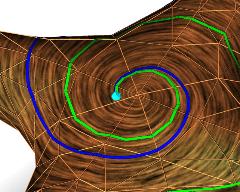Geodesic curves are a fundamental concept in geodesy and mathematics to generalize the concept of a "straight line" to arbitrary curved surfaces and general manifolds. A simple example is the application to curves on round spheres: here the concept of geodesics leads to the definition of great arcs which are the shortest and straightest curves on earth.
 The
straight line property of geodesics makes them a helpful concept
in the generalization of standard numerical methods to arbitrary
surfaces. As an example, consider an Euler method for the
integration of a vector field v on a curved surface: here
one proceeds a small distance h from one point p to
a next point q along the straight line with the direction
of the vector field v(p)
given at p. Obviously, this definition is not complete
since the straight line may never again hit the surface and
p+hv(p) usually does not lie on the surface. Therefore
ambiguous projection algorithms are needed and they are often the
reason of severe problems. Instead of proceeding along a euclidean
straight line one should proceed along the geodesic through p
with initial direction v(p) of the vector field. As a
consequence, these ideas lead to the generalization of Euler and
other Runge-Kutta methods to arbitrary surfaces and allow an
intrinsic definition of numerical methods which does not need an
ambient space for numerics on a manifold.
The
straight line property of geodesics makes them a helpful concept
in the generalization of standard numerical methods to arbitrary
surfaces. As an example, consider an Euler method for the
integration of a vector field v on a curved surface: here
one proceeds a small distance h from one point p to
a next point q along the straight line with the direction
of the vector field v(p)
given at p. Obviously, this definition is not complete
since the straight line may never again hit the surface and
p+hv(p) usually does not lie on the surface. Therefore
ambiguous projection algorithms are needed and they are often the
reason of severe problems. Instead of proceeding along a euclidean
straight line one should proceed along the geodesic through p
with initial direction v(p) of the vector field. As a
consequence, these ideas lead to the generalization of Euler and
other Runge-Kutta methods to arbitrary surfaces and allow an
intrinsic definition of numerical methods which does not need an
ambient space for numerics on a manifold.
As an application of intrinsic numerics, we study point waves on surfaces like the torus and the pretzel. When considering wave fronts as a collection of particles, the particles issued at a point on a surface move along geodesics and the wave front evolves through distance circles whose center is the origin of the wave. Remarkable singularities of wave fronts on surfaces occur after a short period of the evolution: although a surface may be arbitrarily smooth: a wave front develops caustics after having surpassed a region with a certain amount of positive curvature. These singularities are the singular points of the differential of the exponential map which play an important role in the study of surfaces in differential geometry and the properties of so-called discrete geodesics.
The definition of straightest geodesics on piecewise planar surfaces transfers the ideas from the smooth case to discrete surfaces which are essential for numerical computations, for example, our use of geodesics in the integration of vector fields on surfaces. Here we refer to technical papers [3][4].
There are two ideas central in our mathematical work: first, the application of ideas from differential geometry to the adaption of standard numerical methods to problems on arbitrary surfaces, and second, the redefinition of differential geometric terms on piecewise linear surfaces. Such discrete surfaces are heavily used in numerics and visualization, it is therefore suitable to transfer ideas from smooth geometry to such discrete geometries. This allows to reduce accuracy problems since appropriate discrete algorithms operate exactly on discrete data and there is only small accumulation of numerical errors.
The visualization of waves on arbitrary surfaces was a major task. Such waves overlap some regions of the surface a number of times and interfere with other parts of the wave. Firstly, we used a locally isometric texture map technique for arbitrary surfaces consisting of planar triangles which allows surfaces to carry non-distorting texture maps. And secondly, we defined an extension allowing multiple coverings of the surface with texture layers. This technique allows surfaces to carry textures where each point of the surface has an associated stack of texel values and the height of the stack may vary over the surface. We call this a branched texture map, similiar to branched covering maps in mathematics, but different from the use of so-called local texture maps in animations systems. Each segment of the wave is associated to a certain texture layer which need not cover the whole surface and the layer is independent of a triangulation of the surface. When the numerics are done and the evolution of the wave is computed, we blend the texel values of each stack to simulate the interference. The resulting texel value is associated to the point on the surface.